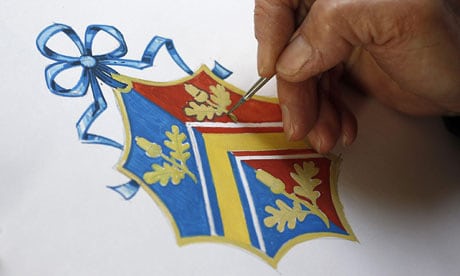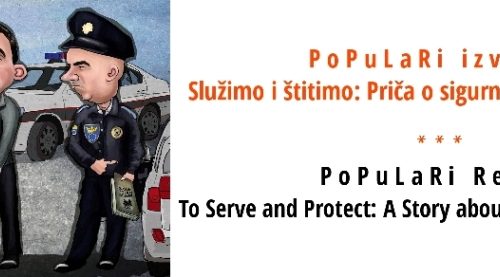
Politics, People and Boxing Gloves
Official symbols often play an important role in the formation of identity. As this can frequently have meaningful political significance, Populari decided to gather and analyze the coat of arms of each Bosnian municipality. This country-wide perspective provided us with the opportunity to visually analyze the messages these symbols transmit, and determine if any trends emerged.
To prepare a princess-to-be, the heralds at the College of Arms designed a coat of arms for Kate Middleton the week before her marriage to Prince William. The College of Arms is the official heraldic society in the United Kingdom which creates visual identities for families and individuals since its establishment during the 15th century. The Garter King of Arms explained that after the wedding, Catherine Middleton places her father’s arms beside those of her husband in a symbolic gesture of a new union, which will require a royal warrant from the Queen.
Although not strictly necessary, such coats of arms are constructions of collective identity found all over the world. Some heraldic symbols seem purely ceremonial, like those created for royal weddings, while others provoke debate and even controversy. Last year thousands of people gathered in Prizren, Kosovo to protest the Kosovo Constitutional court decision that the city coat of arms should be changed for only reflecting an Albanian majority. Minority groups petitioned the change citing values of the constitution, while the majority demonstrated to protect history. More recently, a top Muslim cleric called for a crescent moon to be added to Russia’s state coat of arms to represent the country’s estimated eighteen percent Muslim population.
Government-assigned symbols visually provide insight into political and social dynamics, closely mirroring the evolution of a particular country or region. Tito`s Yugoslavia displayed many symbolic markings to strengthen a powerful image for the communist government. The red star of communism, one of the most prominently seen examples, was stamped on every official document, hanging in factories and schools, and found on car license plates. The six republics in Yugoslavia each had their own coat of arms but all displayed the red star clearly.
After decades of uniformity, none kept the red star as part of its national symbol today, as they constructed new visual identities as independent nations emphasizing difference. Many people still feel nostalgic when viewing a leftover star on a gravesite or occasional old building, as this symbol was a national identifier that collectively bound Yugoslavia together, at least on the surface. The fading away of this red star shows only one instance in which political symbols trace the evolution of the self-identification of a country.
Presently in Bosnia and Herzegovina (BiH), there are many government-adopted symbols marking all levels of administration, but some are much less visible than others. Intrigued by local governance and interactions on the community level, Populari chose to investigate the current municipal coats of arms in BiH, as this level of government is closest to the citizens. Scattered around the country in dusty municipality buildings, stamped on important documents or visible on local souvenirs, these coats of arms present valuable indications of local governance practices. How do local authorities determine which design best represents the citizens? In order to gain a country-wide perspective, Populari created a database of these heraldic symbols to visually analyze the way municipalities self-identify their citizens.
Although 109 existed before the 1992-1995 war, there are currently 142 municipalities in BiH and all but thirteen municipalities use a coat of arms. Municipal officials are responsible for adopting a coat of arms used to represent their communities, so most start the process by forming a special jury to select a design through a public call. Not every municipality states their selection criteria explicitly, as evident in the wide variety found, but most terms and conditions generally ask for representation of some aspects of the municipal heritage (natural, historical, cultural, etc). After the competition closes, the jury selects the design, adopts ownership of the coat of arms, and some even reward monetary prizes to the winners – like the hefty sum of about 1500 euros for the designer in Bihać, whereas in Kreševo, for example, the winner was offered purely the honor of contributing to history.
Gathering these symbols from around the country one can immediately observe their vast differences – designed using a wide range of artistic styles, they contain symbols ranging from boxing gloves, various animals, factories, religious symbols, to natural landmarks. This assortment is not surprising, because unlike in some other European countries with centuries-old heraldic traditions, BiH has no College of Arms or established institutions of experts to regulate standards. However, even in this chaotic variety of symbols seen in the database, certain patterns start to emerge, as the municipal officials generally take two approaches in selecting identifiers of the local population: very few use neutral symbols while the majority uses ethnic and/or religious symbolism. While fleur-de-lis, double-headed eagle and the checkerboard clearly identify the three constituent people in BiH, there are many more ethnically charged symbols found on municipal coats of arms throughout BiH.
Three Distinct Ethnic Symbols:
The fleur-de-lis was used on many heraldic symbols during European history since the Crusades. Although most often associated with France, this symbol appears in many countries throughout Europe and North America. Used in medieval Bosnia in the 14th century, the fleur-de-lis was revived officially in 1992 as a state symbol of Republic of Bosnia. After the Dayton Agreement, Bosnian Serb and Bosnian Croat political representatives requested the state symbols to be changed, which was enforced by the international community in 1999. This symbol became increasingly equated with the Bosniak community today.
The double-headed eagle heraldic symbol is most commonly attributed to the Byzantine Empire and Holy Roman Empire and several Eastern European nations use the symbol to this day. This eagle has been linked to Serbia since the 15th century, and also gained prominence for Bosnian Serbs since the 19th century. Since the usage of the national/ethnic symbols was limited during communism, it experienced true revival in the early 1990s, in Serbia and also by Bosnian Serbs. This symbol is seen on the current Serbian state coat of arms and previously on a Republika Srpska coat of arms, until the Constitutional Court deemed it discriminatory2007, but the symbol remains an identifier of Serbian communities.
The origin of checkerboard is difficult to determine given its simplistic design but its usage by Croat communities can be dated to the late 15th or early 16th century. After independence from Yugoslavia in 1991, it was re-adopted as the official symbol of Croatia. About the same time, Bosnian Croats adopted a slightly modified checkerboard as a symbol of para-statelet of Herceg Bosna. After Herceg Bosna was abolished in 1994, this symbol continued to be used on coat of arms of many municipalities and cantons in Bosnia, attributed with Croatian communities.
Although there is much debate over origins and interpretations, these symbols are not inherently offensive. If shown elsewhere and in different context, they would be a subject of somewhat different interpretations. Combined with the political and social circumstances in this region, however, these symbols became associated with war related events. Although all of these symbols have been removed by the Constitutional Court from any of the State and the entity level markings, they remain present. The best example is the 2005 Armed Forces unification in BiH, when the three regiments have retained the right to wear these symbols alongside (or rather on the opposite shoulder of) the BiH flag.
By looking at the database, it is evident that most civic heraldic symbols in BiH were established only recently.
In fact, only two municipalities in the whole country – Maglaj and Tuzla – are still using a coat of arms adopted before the war. “There was no need to change the coat of arms because it perfectly represents our municipality and its inhabitants,” Alena Efendi? in the Mayor’s Office of the Municipality of Maglaj explained. Some, like the City of Sarajevo, have only slightly adjusted their socialist coat of arms, but most of them changed dramatically in the post-war period.
Considering when the majority of the coats of arms have been adopted, the presence of many ethnic symbols is really not surprising. The war forced ethnic identity to the forefront, and divided people along ethnic lines. As defining collective identity boundaries resurfaced more dominantly, the municipal symbols inevitably portray this change, most reflecting only sentiments of the ethnic majority.
Having said that, the Dayton Agreement legal framework introduced the concept of `constituent people`, which means, as confirmed by the Constituent Peoples` Decision of the BiH Constitutional Court in 2000, that none of the three constituent groups – Bosniaks, Bosnian Serbs, and Bosnian Croats – is constitutionally recognized as a majority anywhere in Bosnia, and the groups should `enjoy equality` everywhere. Looking at the municipal coats of arms, it is evident that these conditions are not always so welcoming in practice, as many of them use symbols that represent one ethnic or religious group exclusively.
While the majority of people can walk indifferently by government-assigned heraldic symbols in their communities or cities, others may feel directly confronted by the interpretations of their messages. Taking into account the recent war, not surprisingly the emotional charge carried by the symbols is reminiscent of atrocities seen or experienced. A returning refugee, for example, might feel directly offended or ostracized by municipality-chosen identifiers when simply visiting the office for administrative matters.
As a result of feeling discriminated, legal actions were taken in the past fifteen years challenging the exclusive dimension of modern Bosnian heraldry on the entity, cantonal and municipal levels of administration. There were 23 cases raised against discriminative content of municipal coats of arms investigated in both entities` constitutional courts.
Only last month, the FBiH Constitutional Court ruled that the coat of arms in Kiseljak municipality did not comply with the constitution or Constituent Peoples` Decision, after a citizen found its symbols discriminatory.
The coat of arms currently contains both lilies and the checkerboard symbols, and will have to be changed, as it does not reflect Serbs and other groups who also live in the municipality. It is worth mentioning that currently no single municipality in both entities contains fleur-de-lis, double-headed eagle and the checkerboard symbols all together.
Coats of arms and other heraldic symbols are seen all over the world, constructing identity whether for a royal family celebrating an upcoming wedding or for a municipal community. Although the symbols of collective identity linked to ethnicity are not inherently offensive, political and other external circumstances dynamically change the meaning of such identity constructions. The variety of symbols contained in municipal coats of arms in BiH reflects a period of transition that the country is facing today. This mirror image of contemporary BiH, as portrayed by the municipal coat of arms, illustrates the difficulties of striking a balance in a multi-cultural society. Although the majority of the coats of arms are displaying mono-ethnic symbols, thus triggering negative response of the “ethnic minority” in a certain area, the Kiseljak and other court cases over discriminatory heraldry will require an epilogue that will test the local authorities` ability to compromise, while retaining their ethic distinctiveness.





